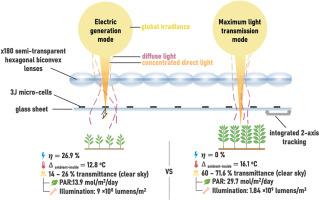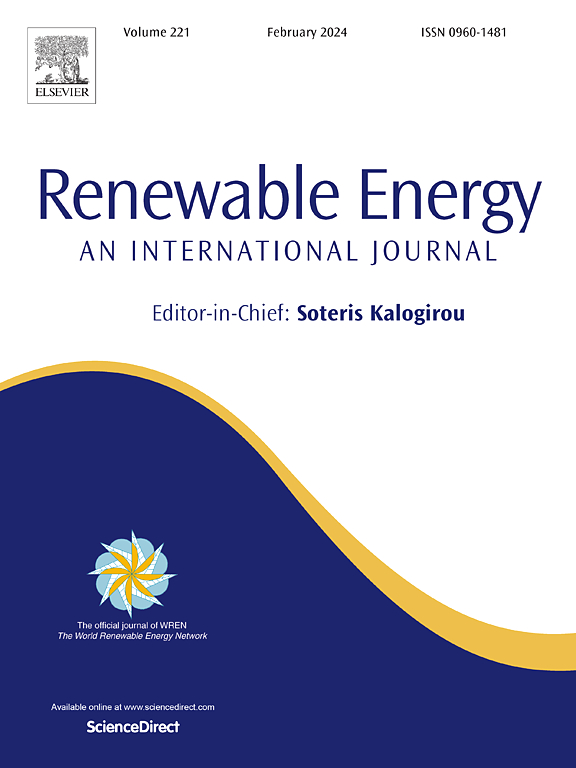A crop-agnostic baseline for agrivoltaics: Field-Proven characterization of Micro-CPVs with diffuse light transmission
IF 9.1
1区 工程技术
Q1 ENERGY & FUELS
引用次数: 0
Abstract
Traditional concentrator photovoltaics (CPV) systems cannot capture diffuse light and require bulky sun-tracking. In this work, we characterize a commercially oriented, semi-transmissive, micro-CPV with integrated tracking optically, thermally, and electrically under the sand-laden, hot desert climate of Abu Dhabi, United Arab Emirates to evaluate its potential for agrivoltaics and ability to contribute towards the interplay of the food-energy nexus. When the module operates in an “Electricity” mode (E-mode) by focusing direct light on micro-cells, the peak electrical efficiency was 26.9 % while 14–26 % of the incoming irradiance was uniformly transmitted as diffuse light underneath. When climate conditions are not favourable for electric generation, switching to a “Maximum Light Transmission” mode (MLT-mode) yielded a transmittance up to 71.61 %, providing a daily illuminance (daylighting applications) of 1.84 × 109 lumens m−2 day−1 and Daily Light Integral (DLI) dose of 29.69 molPAR m−2 day−1, suitable for moderate-to-high light crops. On the thermal front, the air temperature beneath the panel surpasses the ambient temperature by a range of 10–15 °C, and the solar cell temperatures ran 27 °C above ambient at midday. Based on the data and observations of a 1-year crop-agnostic module characterization, we identify design improvement and manufacturing errors, mostly in the field of optics and tracking-integration.

农业发电的作物不可知基线:具有漫射光传输的微型cpv的现场验证表征
传统的聚光光伏(CPV)系统不能捕获漫射光,并且需要庞大的太阳跟踪。在这项工作中,我们在阿拉伯联合酋长国阿布扎比的多沙、炎热的沙漠气候下,对一种商业导向的、半透射的、集成了光学、热和电跟踪的微型cpv进行了表征,以评估其在农业发电方面的潜力以及对粮食-能源关系相互作用做出贡献的能力。当该模块工作在“电”模式(e模式)下,通过将直射光聚焦在微电池上,峰值电效率为26.9%,而14 - 26%的入射光以漫射光的形式均匀传输。当气候条件不利于发电时,切换到“最大光透射”模式(mlt模式)的透射率高达71.61%,日照度(采光应用)为1.84 × 109流明m−2天−1,日光积分(DLI)剂量为29.69摩尔par m−2天−1,适用于中高光作物。在热前沿,面板下的空气温度超过环境温度10-15°C,正午时太阳能电池的温度比环境温度高27°C。基于1年作物无关模块特性的数据和观察,我们确定了设计改进和制造错误,主要是在光学和跟踪集成领域。
本文章由计算机程序翻译,如有差异,请以英文原文为准。
求助全文
约1分钟内获得全文
求助全文
来源期刊

Renewable Energy
工程技术-能源与燃料
CiteScore
18.40
自引率
9.20%
发文量
1955
审稿时长
6.6 months
期刊介绍:
Renewable Energy journal is dedicated to advancing knowledge and disseminating insights on various topics and technologies within renewable energy systems and components. Our mission is to support researchers, engineers, economists, manufacturers, NGOs, associations, and societies in staying updated on new developments in their respective fields and applying alternative energy solutions to current practices.
As an international, multidisciplinary journal in renewable energy engineering and research, we strive to be a premier peer-reviewed platform and a trusted source of original research and reviews in the field of renewable energy. Join us in our endeavor to drive innovation and progress in sustainable energy solutions.
 求助内容:
求助内容: 应助结果提醒方式:
应助结果提醒方式:


